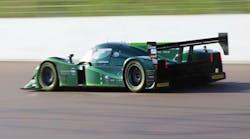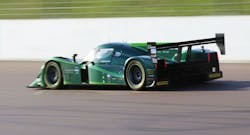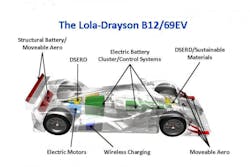Drayson Racing Technologies will try to set a new FIA World Electric Land Speed Record this month in the under 1,000-kg category. The car, a slightly modified B12 69/EV, will be driven by Lord Drayson, the company’s co-founder and a one-time science minister for the U.K. The attempt will take place at RAF Elvington on the airfield’s 1.86-mile runway.
The current record, 175 mph, was set by Battery Box General Electric in the U.S. in 1974. This record has not been broken in 40 years due to the challenge of running an electric vehicle consistently and reliably at such speeds when weighing less than 2,200 lb. According to Drayson, “It is not the outright speed that is impressive about this record attempt, but the engineering challenge of accelerating a 1,000-kg electric vehicle to such a high speed, sustaining that speed over a measured mile, stopping safely within a relatively short distance, then turning round and doing it again within an hour.”
The B12 69/EV was partially conceived as an entrant in the new Formula E Series, a new race series for electric vehicles. The racer generates over 850 hp and can hit speeds of 200 mph or more. The batteries, Nanophosphate cells made by A123 Systems, power four rear-mounted, axial-flux motors. All the motors’ tractive force gets channeled through the rear wheels. There is no transmission; a single reduction gear links the electric drives to the driveshaft. And batteries are recharged via induction coils in the floor of the car. These let the car recharge when parked over a charging pad.
For the record attempt, some changes have been made to the drivetrain and set-up of the car so that downforce is minimized. This will give the race car enough traction to quickly get to its top speed and stop within the distance available.


